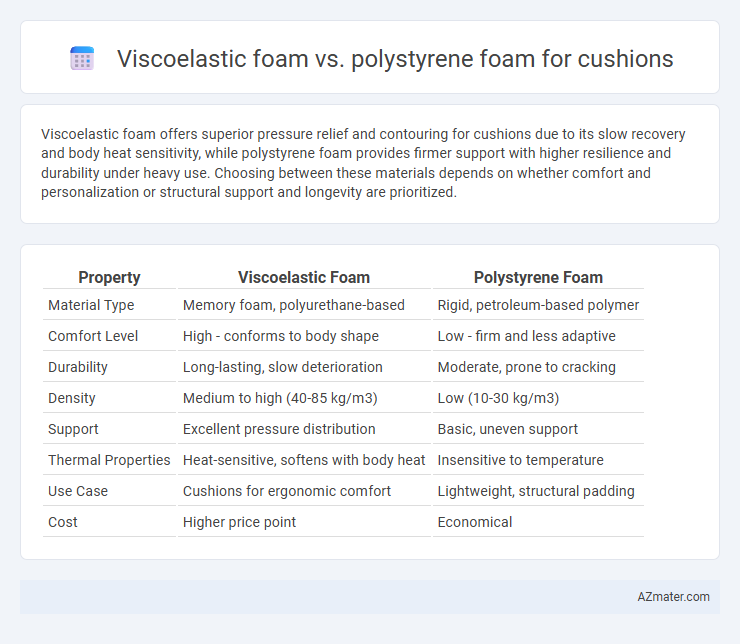Viscoelastic foam offers superior pressure relief and contouring for cushions due to its slow recovery and body heat sensitivity, while polystyrene foam provides firmer support with higher resilience and durability under heavy use. Choosing between these materials depends on whether comfort and personalization or structural support and longevity are prioritized.
Table of Comparison
| Property | Viscoelastic Foam | Polystyrene Foam |
|---|---|---|
| Material Type | Memory foam, polyurethane-based | Rigid, petroleum-based polymer |
| Comfort Level | High - conforms to body shape | Low - firm and less adaptive |
| Durability | Long-lasting, slow deterioration | Moderate, prone to cracking |
| Density | Medium to high (40-85 kg/m3) | Low (10-30 kg/m3) |
| Support | Excellent pressure distribution | Basic, uneven support |
| Thermal Properties | Heat-sensitive, softens with body heat | Insensitive to temperature |
| Use Case | Cushions for ergonomic comfort | Lightweight, structural padding |
| Cost | Higher price point | Economical |
Introduction to Cushion Foam Materials
Viscoelastic foam, commonly known as memory foam, adapts to body shape by responding to heat and pressure, offering superior comfort and pressure relief for cushions. Polystyrene foam, a lightweight, rigid material made from expanded beads, provides excellent structural support and durability but lacks the contouring ability of viscoelastic foam. Choosing between viscoelastic and polystyrene foam depends on the desired balance between comfort, support, and application-specific requirements in cushion design.
What is Viscoelastic Foam?
Viscoelastic foam, commonly known as memory foam, is a material characterized by its slow response to pressure and temperature sensitivity, providing exceptional comfort and support by contouring to the body's shape. Unlike polystyrene foam, which is lightweight and rigid, viscoelastic foam offers superior energy absorption and pressure relief, making it ideal for cushioning applications that require enhanced durability and comfort. Its viscoelastic properties result in reduced motion transfer and increased shock absorption, distinguishing it from the more traditional, less adaptive polystyrene foam.
Understanding Polystyrene Foam
Polystyrene foam, widely used in cushions, is a lightweight, rigid material known for its excellent insulation and structural support properties. Unlike viscoelastic foam, which conforms to body shape through its slow recovery and pressure distribution capabilities, polystyrene foam provides firm, consistent cushioning with limited flexibility. Its high compressive strength and moisture resistance make polystyrene foam ideal for impact absorption and durability in applications requiring long-lasting, stable cushioning.
Key Material Properties Comparison
Viscoelastic foam features high energy absorption, slow recovery rate, and excellent pressure distribution, making it ideal for ergonomic cushioning applications. Polystyrene foam offers rigid structure, low density, and high compressive strength, often used for lightweight protective packaging. The key material properties comparison shows viscoelastic foam excels in comfort and impact damping, while polystyrene foam provides superior stiffness and dimensional stability.
Comfort and Support Differences
Viscoelastic foam, commonly known as memory foam, offers superior comfort and pressure relief by conforming closely to the body, distributing weight evenly, and reducing stress points, making it ideal for cushions that require personalized support. Polystyrene foam, often used in standard cushions, provides firmer support with less conformability, offering durability and resilience but lacking the contouring benefits of viscoelastic foam. The key difference lies in viscoelastic foam's ability to adapt to body shape for enhanced comfort, whereas polystyrene foam prioritizes structural support and longevity.
Durability and Longevity
Viscoelastic foam, known for its high-density structure, offers superior durability and maintains its shape longer under constant pressure compared to polystyrene foam, which tends to degrade and crumble over time. The viscoelastic material provides excellent resistance to wear and tear, making it ideal for cushions requiring long-term resilience. Polystyrene foam, while lightweight and cost-effective, generally lacks the durability and longevity necessary for cushions subjected to frequent use.
Thermal Insulation Performance
Viscoelastic foam offers superior thermal insulation due to its ability to trap air within its open-cell structure, reducing heat transfer and maintaining consistent temperature regulation in cushions. Polystyrene foam, characterized by its closed-cell composition, provides effective insulation but is more rigid and less adaptable to body contours, potentially leading to localized heat buildup. When prioritizing thermal comfort in cushioning, viscoelastic foam is often preferred for its enhanced breathability and thermal regulation capabilities.
Environmental Impact and Sustainability
Viscoelastic foam, derived from polyurethane, often contains chemical additives that can challenge biodegradability and complicate recycling processes, impacting environmental sustainability. Polystyrene foam, though lightweight and insulating, is notorious for persistent environmental pollution due to its slow degradation and low recycling rates, contributing substantially to landfill volume and marine litter. Sustainable cushion choices prioritize materials with lower carbon footprints, higher recyclability, and reduced toxic emissions throughout production and disposal phases.
Cost Considerations
Viscoelastic foam typically incurs higher costs than polystyrene foam due to its advanced material properties and manufacturing process, offering superior pressure relief and comfort that justify the investment for premium cushions. Polystyrene foam remains a cost-effective option favored for budget-conscious applications, providing adequate support but lacking the adaptive contouring benefits of viscoelastic foam. Evaluating long-term durability and comfort efficiency can reveal that the initial higher cost of viscoelastic foam offsets potential replacement and maintenance expenses associated with polystyrene foam cushions.
Choosing the Right Foam for Your Cushion
Viscoelastic foam offers superior comfort by contouring to body shapes and providing excellent pressure relief, making it ideal for cushions used in seating or bedding applications requiring enhanced support. Polystyrene foam is lighter, firmer, and more resistant to moisture, offering durability and structural integrity for cushions exposed to frequent use or outdoor environments. Choosing the right foam depends on the specific needs for comfort, durability, moisture resistance, and usage conditions in your cushion application.

Infographic: Viscoelastic foam vs Polystyrene foam for Cushion
 azmater.com
azmater.com